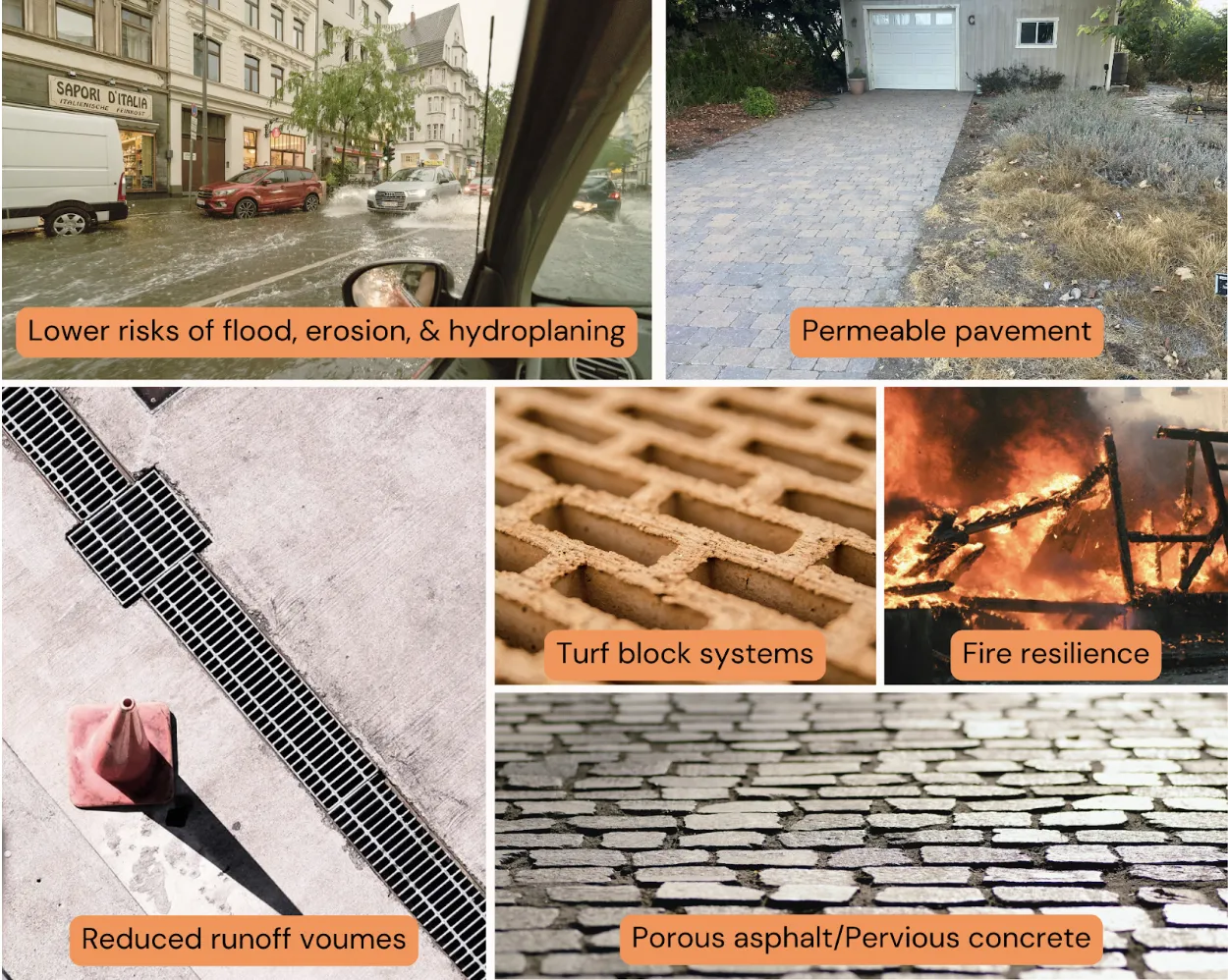Permeable Materials: A Sustainable Approach to Stormwater

Impervious surfaces, such as concrete or asphalt, have enabled large-scale urban development throughout Southern California by providing stable foundations for building structures, facilitating the efficient movement of pedestrians and vehicles, and promptly transporting rainwater away from buildings and streets. However, the rapid intensification of climate change, combined with exponential population growth, has amplified the negative environmental impacts of impervious surfaces, which contributed to increased stormwater runoff and pollution. Because of this, the municipal landscape and water resources management of several communities in the Los Angeles, Orange, Riverside, and San Bernardino counties will only become more at risk. Permeable pavement systems are low-impact development (LID) practices that can offer many of the same benefits as impermeable pavement while also enhancing stormwater management. This post will explain the benefits of permeable pavements as a stormwater practice in urban environments, list the important considerations to keep in mind while designing a permeable pavement system, and highlight successful permeable pavement projects across Southern California.
Definition and Types of Permeable Pavements
Permeable pavements, also referred to as porous, pervious, or infiltrative pavements, are a water-resilient alternative to traditional paved surfaces, allowing rainwater to infiltrate the ground. This best management practice (BMP) supports both municipal and private developments by effectively managing stormwater while providing functional surfaces for transportation and recreation within urban landscapes throughout Southern California. Permeable pavements are low-maintenance and are particularly valuable in developed areas with limited open space, where traditional post-construction stormwater controls that require dedicated land are not feasible. They are ideal for use in driveways, parking lots, and patios. Although these systems go by various names within green infrastructure and low-impact development (LID) practices, they generally fall into the following main categories:
Porous Asphalt/Pervious Concrete:
Modified forms of conventional asphalt and concrete material that contain less fine aggregates, which allows for better water passage. Ideal for large impervious areas like driveways and parking lots. “Pervious concrete can infiltrate stormwater at rates between 120 and 1,200 inches/hour, depending on mix design and porosity” (ACI Committee 522, 2010).
Porous Asphalt:
Similar to traditional asphalt but without the fine aggregates, allowing water to drain through interconnected voids in the surface layer. They can be installed in parking lots, walking paths, and recreational surfaces. “Porous asphalt systems, when coupled with a stone reservoir layer, can reduce surface runoff by 80% or more” (Ferguson, 2005).
Permeable Paver Systems/Permeable Interlocking Concrete Pavement (PICP):
Designs comprising pavers with gaps that facilitate water flow, underpinned by highly porous gravel layers serving as reservoirs. This versatile option suits residential and commercial uses and is typically installed on crushed stone bases. “PICP systems can achieve peak flow reductions of up to 90% and are especially effective in areas with high pedestrian use” (ICPI, 2018).
Turf Block Systems:
Also known as “grass blocks”, they are similar to PICPs but with soil-filled spaces for planting grass or groundcover. Suitable for driveways.
Emerging Innovations
- Hybrid Pavement Systems: Combine permeable surfaces with underground storage and treatment chambers for enhanced stormwater quality and quantity control.
- Photocatalytic Pervious Pavements: New materials that help degrade pollutants like nitrogen oxides from car exhaust, providing air quality co-benefits (Li et al., 2019)
Benefits of Permeable Pavements for Reducing Surface Runoff
Permeable pavement’s enhancement of water percolation can play an essential role in reducing surface runoff. A larger surface area of porous material allows more water to infiltrate urban soils and reduces stormwater discharge. A decrease in runoff volumes would lower the chances of erosion, flooding, hydroplaning, and splashing of pollutant-holding vehicle undercarriages within our local neighborhoods (Stormwater Best Management Practice: Permeable Pavements). Furthermore, permeable pavements can prevent damage to municipal drainage systems by reducing the risk of sewer backups from runoff overflow. The gravel layered below permeable asphalt, pavers, or concrete also filters contaminants to improve water quality of community groundwater recharge basins and surface water bodies.
All of these feats can indirectly contribute to fire safety. The runoff mitigation capabilities of permeable surfaces can also help prevent flooding that may impede the passage of fire trucks or other emergency vehicles in pursuit of fires. Stormwater captured by and stored under porous asphalt could serve as a valuable resource for fire suppression in areas with limited water supply. Finally, permeable pavements can help reduce the urban heat island effect through enhanced infiltration and evaporation, which would cool down the surface and surrounding air.
Design and Installation Considerations for Permeable Surfaces
Although they may be more expensive to install than their non-permeable counterparts, permeable pavers can lead to significant cost savings in flood mitigation and low-maintenance infrastructure. Permeable pavements consist of the surface layer and subsurface layer, with each layer comprising unique material compositions and levels of thickness. Surface layers typically range in thickness from 2 to 4 inches, with added polymers or admixtures to increase strength for handling heavier load applications and/or enhancing stormwater management properties. Subsurface layer design can vary substantially depending on the choice of permeable pavement type and project-specific requirements. However, all permeable pavement types should consider the following factors when designing and before installation: slope, location, and maintenance of the area.
Slope
- Designated surfaces should exhibit slopes no greater than 5% since steeper slopes can cause pavement to shift and reduce its ability to manage stormwater.
- It must be ensured that the slope of a pavement does not lead to water flow occurring out of the stone reservoir layer onto lower portions of the pavement surface (Permeable Pavement Systems).
Location
- It is recommended to AVOID placing permeable pavements on high pollutant sites or locations with constant trash or debris. Unless regular vacuuming is feasible, refrain from installing in locations affected by windborne dust and sediment.
- Instead of areas that store or handle toxic fuels and chemicals, prioritize regions that are pedestrian and vehicular transport-friendly.
- Areas with low-volume roads, low-speed zones, overflow parking, residential driveways, alleys, and parking stalls (Design criteria for permeable pavement).
- Setback and separation guidelines for permeable pavements require a minimum horizontal distance of 50 feet (100 feet recommended) between water supply wells and your installation. Regarding vertical separation, there must be at least 3 feet of undisturbed soil between the bottom of the permeable pavement reservoir layer and bedrock.
Area Maintenance
- Permeable surfaces must be cleaned regularly to prevent clogging from sand, sediment, and debris.
- Vacuuming at least twice a year can help maintain permeability.
- Site developers should also consider the infiltration capacity of a particular type of pavement or paver system. One can incorporate inlets to accommodate for occasional field clogging or overflows from extreme storm events.
Case Studies of Successful Permeable Pavement Projects
Numerous successful installations demonstrate the viability of permeable pavements in the region:
- Riverside County Flood Control and Water Conservation District: As part of its project to create anti-polluting infrastructure that uses or mimics natural processes, the district constructed permeable pavement systems on its campus to assess the efficacy of various low impact development (LID) stormwater best management practices (BMP) within arid regions.
- This included complementary aesthetic designs for pervious pavers, porous concrete, and porous asphalt.
- Each design has the potential for groundwater recharge facilitation, pollutant concentration reductions, stormwater runoff reduction, and infiltration enhancement.
- Initial testing emphasized necessary rehabilitation of the district's permeable pavement systems, which will only lead to improved designs in the future.
- This included complementary aesthetic designs for pervious pavers, porous concrete, and porous asphalt.
- South Coast Research and Extension Center: Our site exhibits a demonstration of permeable pavement implementation on residential driveways. Three model homes were constructed side-by-side-by-side to show the effectiveness of 3 different types of pavement systems against stormwater runoff: 1) Impervious surface driveway, 2) Driveway combining traditional concrete with impermeable pavement, and 3) Fully permeable paver system driveway. The level of stormwater management capacity increases as you go down the examples from models 1 to 3.
- The project is currently undergoing a revitalization process before continuing its construction. Once finished, we wish to share our demonstration and findings with the public.
- Los Angeles County: There are several successful permeable pavement projects that are a part of LA’s green infrastructure and low-impact development programs. Modeled mainly after Seattle’s Street Edge Alternatives (SEA) initiative, this includes David Hertz Studio’s modified parking lot in Santa Monica, mass permeable pavement installation in the City of Manhattan Beach, and multiple pervious paver systems throughout the city of Los Angeles.
- Los Angeles County; Elmer Avenue Retrofit Project: This residential green street retrofit included permeable pavements, bioswales, and underground infiltration trenches. It reduced neighborhood flooding and increased groundwater recharge by over 50 acre-feet annually (TreePeople, 2014).
- Orange County; UC Irvine Green Infrastructure Projects: UC Irvine incorporated permeable parking lots and pedestrian paths in campus developments, improving stormwater retention while contributing to LEED certification and student sustainability education (UCI Facilities Management, 2019).
- San Diego County; San Diego’s Chollas Creek Watershed Project: As part of a broader green infrastructure initiative, permeable surfaces were installed in public parks to manage runoff and improve creek water quality, benefiting downstream disadvantaged communities (City of San Diego, 2020).
References
1. Permeable Pavement. (2020). www.portland.gov
2. Stormwater Best Management Practice Permeable Pavements Minimum Measure: Post Construction Stormwater Management in New Development and Redevelopment Subcategory: Infiltration. (2021). www.epa.gov
3. Ecoraster. (2022, October 11). Benefits of Permeable Paving | Ecoraster North America. ecorastergrid.com
4. Design criteria for permeable pavement - Minnesota Stormwater Manual. (2010). stormwater.pca.state.mn.us
5. 3.5 Permeable Pavement Systems. (n.d.). doee.dc.gov
6. Home - Riverside County Watershed Protection. (2023, July 11). Riverside County Watershed Protection. rcwatershed.org
7. Kung, M. (2023, June). Race and Stormwater in LA County. ArcGIS StoryMaps; Esri. storymaps.arcgis.com
8. University of Delaware. (2024). Permeable Vs. Impermeable Surfaces | Cooperative Extension | University of Delaware. www.udel.edu
9. Low impact Development (LID) Projects | California State Water Resources Control Board. (2024). Ca.gov. www.waterboards.ca.gov
10. CALIFORNIA SEA GRANT EXTENSION UNIVERSITY OF CALIFORNIA COOPERATIVE EXTENSION. (2009). Green Sheet Series #6 June 2009. caseagrant.ucsd.edu
11. Brattebo, B. O., & Booth, D. B. (2003). Long-term stormwater quantity and quality performance of permeable pavement systems. Water Research, 37(18), 4369–4376.
12. Chopra, M., Kakuturu, S. P., Ballock, C., Spence, J., & Wanielista, M. (2010). Effect of clogging on the filtration performance of a modular pervious concrete paving system. Journal of Irrigation and Drainage Engineering, 136(9), 653–661.
13. City of San Diego. (2020). Green Infrastructure Implementation Strategy. Stormwater Department.
14. Dietz, M. E. (2007). Low impact development practices: A review of current research and recommendations for future directions. Water, Air, & Soil Pollution, 186(1-4), 351–363.
15. Hunt, W. F., Jarrett, A. R., Smith, J. T., & Sharkey, L. J. (2006). Evaluating bioretention hydrology and nutrient removal at three field sites in North Carolina. Journal of Irrigation and Drainage Engineering, 132(6), 600–608.
16. Leopold, L. B. (1968). Hydrology for urban land planning: A guidebook on the hydrologic effects of urban land use. U.S. Geological Survey Circular 554.
17. Li, H., Harvey, J. T., & Holland, T. J. (2013). Relative cooling performance of permeable pavements: A laboratory study. Environmental Research Letters, 8(1), 015023.
18. Pratt, C. J., Mantle, J. D. G., & Schofield, P. A. (1995). UK research into the performance of permeable pavement, reservoir structures in controlling stormwater discharge quantity and quality. Water Science and Technology, 32(1), 63–69.
19. Scholz, M., & Grabowiecki, P. (2007). Review of permeable pavement systems. Building and Environment, 42(11), 3830–3836.
20. TreePeople. (2014). Elmer Avenue Neighborhood Retrofit: Green Infrastructure Demonstration Project.
21. UCI Facilities Management. (2019). Sustainable Stormwater Infrastructure on Campus.
22. U.S. Environmental Protection Agency (EPA). (2020). Stormwater Management Best Practices: Permeable Pavement. Washington, D.C.
23. ACI Committee 522. (2010). Report on Pervious Concrete (ACI 522R-10). American Concrete Institute.
24. Ferguson, B. K. (2005). Porous Pavements. CRC Press.
25. Interlocking Concrete Pavement Institute (ICPI). (2018). Permeable Interlocking Concrete Pavement: Design Specification and Construction Guide.
26. Li, H., Ma, J., & Guo, X. (2019). Advances in photocatalytic pervious concrete: A review. Construction and Building Materials, 215, 791–802.
27. U.S. Environmental Protection Agency (EPA). (2020). Stormwater Management Best Practices: Permeable Pavement. Retrieved from https://www.epa.gov/npdes
About the Authors

Daniel Gonzalez II is an associate research and extension specialist at SCREC under the Grizzly Corps Fellowship Program. He focuses on researching and developing nature-based solutions for stormwater management practices in Southern California. Drawing from his background as a certified K-12 educator, Daniel is excited to make watershed and climate-resilient resources more accessible for local communities across Southern California.
Contact at dgonzalezll@berkeley.edu

Dr. Esther N Lofton is an Urban Watershed Resilience Advisor serving Orange, Los Angeles, San Bernardino, and Riverside Counties. She focuses on drinking and environmental water quality, water use efficiency, water supply security, and water equity. Her research is conducted at various scales, such as surface and ground water basins, watersheds, neighborhoods, and field or household scales. Her research is geared towards providing recommendations and guidance to stakeholders such as watershed and stormwater managers, policy makers, and the public to make better decisions on water resources management.
Contact at enmosase@ucanr.edu or (858) 282-6737
